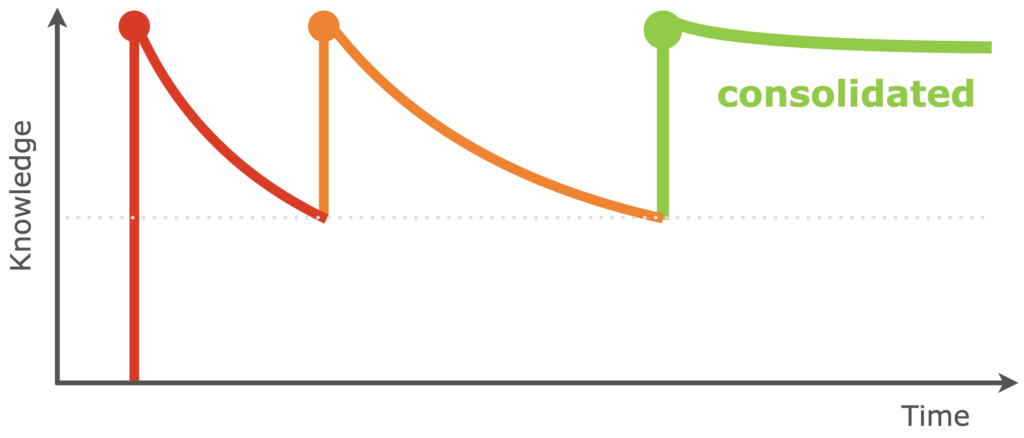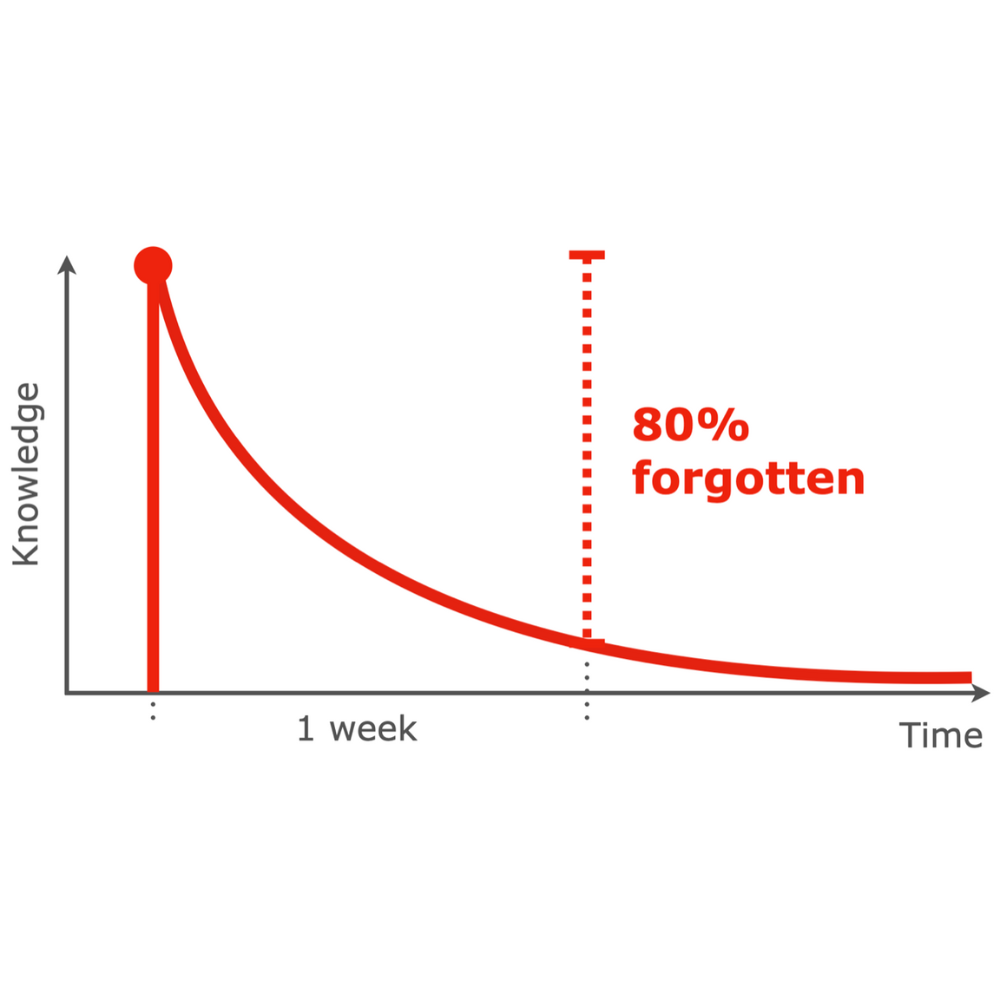How artificial intelligence can help entrepreneurs turbo-charge knowledge transfer to new team members
30-second summary for busy leaders
- Once a business has reached product-market fit, entrepreneurs need to hire new employees as they can’t do everything themselves.
- But before new employees are effective, senior people need to transfer some of their knowledge.
- The problem with traditional onboarding and training sessions is that after one week 80% of the new knowledge is forgotten.
- This is because traditional approaches don’t consider insights from learning research that have been known since the end of the 19th century and have been confirmed by recent findings in neuroscience.
- Using artificial intelligence, entrepreneurs can turbo-charge their training and development programs with almost no additional effort.
The challenges of growing organisations
In the early stages of building a business, entrepreneurs have their hands on all aspects of the organisation. On any given day, they may share their time between developing a new feature for the product, talking to customers, pitching an investor, and wrapping up some administrative tasks. Things move fast, and the core founding team accumulates an enormous amount of domain expertise and know-how.
When they reach product-market fit and success becomes overwhelming, entrepreneurs can no longer perform all tasks themselves. The logical next step is to grow the company’s capabilities by hiring more employees and delegating responsibilities to them. This is where things may start to go wrong.
All the knowledge accumulated by the founders through sheer passion and painstaking experiences may now feel obvious to them but conveying it fast and efficiently to new comers is often much more challenging than they anticipate.
The problem with traditional knowledge transfer methods
The traditional approach to transferring knowledge to new employees involves having leaders or experienced employees create training content that captures subject matter expertise. In an audit firm, for example, senior employees may write down everything they’ve learned about Swiss accounting standards in a deck of slides to be shared with new auditors. This knowledge-intensive content is then presented to new employees during condensed onboarding sessions or dedicated training sessions.
The reality shows, however, that such approaches are highly ineffective. After several months on the job, new employees still ask naive questions, showing that they have not assimilated the required contents and cannot operate autonomously. This frustrates the leaders who cannot understand the lack of progress and find themselves repeating “But I already explained that to you!”
Instead of surfing on the expected growth, the company risks stagnation due to a lack of effective knowledge transfer. Far from being able to delegate tasks, senior people waste a lot of time demonstrating the same things over and over again to new employees.
Lessons from the learning sciences
The ineffectiveness of intense onboarding sessions can be understood by turning to the learning sciences. Indeed, the traditional approach clashes with several key recommendations from decades of scientific research to determine which learning approaches work and which don’t.
The main problem lies in the limited processing capacity of the human brain, which quickly finds itself in a situation of cognitive overload when faced with too much new information. Although after an intense training session it may feel like the transmission of the information is successful, very little of it gets mastered for the long term.
It has been known since the late 19th century that we forget what we learn exponentially fast, with as much as 80% forgotten after just one week. This means that 80% of the effort put into the onboarding (or any other training session) is wasted after just one week.

So, what is the alternative? The best way to combat forgetting is to spread the learning process over time and periodically reactivate the new knowledge. The challenge is to ensure the reactivations do not occur too early or too late, but just when some new piece of knowledge has been “half-forgotten”.
These recurring reactivations motivate the brain to store new knowledge in long-term memory, from which it can be retrieved whenever needed.

Another pitfall is that well-meaning experts often attempt to communicate to new employees how to perform a complex task in a realistic situation. While that is indeed the goal of the training, learning sciences show that we don’t learn well that way. Rather than overwhelming new employees with the full complexity of tasks they will eventually perform, it is much more effective to start by decomposing complex tasks into essential building blocks. Through simple learning units, new employees develop the required familiarity and confidence to connect building blocks gradually into more complex activities.
Finally, personalisation is key for the success of onboarding programs. Research shows that learners who benefited from personalised learning content performed radically better than those in groups. The reason is obvious. Each employee has a different background, pre-existing knowledge, learning abilities, and objectives. It’s natural that the onboarding process cannot be effective if it is not adapted to the specific needs of new employees.
How AI can help
At this point, you may be asking yourself: “How on earth should I implement all these theoretical recommendations? I simply don’t have the time for this spaced repetition and personalised content stuff!”
If we have to implement recommendations from the learning sciences to make onboarding effective, it would appear that this implies a lot more work from the founders and leaders, which would be counter-productive. Luckily, as we are in the 21th century, artificial intelligence (AI) can come to the rescue.
Artificial intelligence, or machine learning, concerns computer systems that can improve themselves through experience. In the context of onboarding, a personal AI tutor can interact with new employees and quickly learn how much they already know, what they still need to learn, and how to best help them learn. This increases onboarding efficiency because the right content is shown to the right employee depending on their needs and abilities.
A personal AI tutor also gradually understands how fast every new employee forgets and adapts the sequence of reactivations accordingly. With a minimal time investment of only a few minutes per day, employees consolidate all the key knowledge necessary for them to become operational. This personalised learning empowers them to start performing faster and better.
And the best is that all this requires almost no additional work for content creators. The AI tutor stimulates new employees with simple learning units that are automatically generated based on the experts’ original documents. These interactive microlearning contents take a variety of formats, from multiple-choice questions to key points, personalised for each employee.
Managers also benefit from increased knowledge visibility. Given that personal AI tutors continuously predict the knowledge levels of all employees, they can also create dynamic knowledge visualisations and metrics. This provides useful insights for managers, who can monitor the desired progress.
In conclusions, by implementing recommendations from learning sciences thanks to personal AI tutors, companies can make onboarding much more effective and consolidate their growth.
More about how this looks in practice in our next article.
Authors
Maxime Gabella, Founder & CEO, MAGMA Learning
Andreas Wettstein, Managing Partner, Agility3
What next?
If what I wrote above resonates with you, let’s have a 15-minute chatIn the meantime, take care, stay safe, and get meaningful work done.
